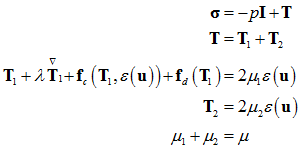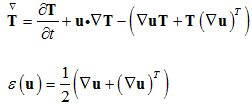VISCOELASTIC_MODEL
Specifies a viscoelastic model for the flow equation.
Type
AcuSolve Command
Syntax
VISCOELASTIC_MODEL("name") {parameters...}
Qualifier
User-given name.
Parameters
- type (enumerated) [=none]
- Type of the viscoelastic model.
- none
- No viscoelastic model.
- oldroyd_b
- Oldroyd-B model describing the viscoelastic behavior of fluid. Requires time_constant and viscosity_model.
- giesekus
- Giesekus model describing the viscoelastic behavior of fluid. Requires time_constant, giesekus_mobility_factor and viscosity_model.
- phan_thien_tanner or ptt
- Requires time_constant, phan_thien_tanner_extensibility_factor, phan_thien_tanner_differential_ratio, and viscosity_model.
- user_function_viscoelastic
- User-defined function. Requires user_function, user_values and user_strings.
- viscosity_model (string) [none]
- Refers to viscosity of the polymer. Valid models are described in the VISCOSITY_MODEL command. Used with oldroyd_b, giesekus, and phan_thien_tanner types.
- time_constant (real) >=0 [=0]
- Relaxation time. Used with oldroyd_b, giesekus, and phan_thien_tanner types.
- time_constant _multiplier_function (string) [none]
- Multiplier function used for scaling the time constant. Used with oldroyd_b, giesekus, and phan_thien_tanner types.
- giesekus_mobility_factor or giesekus_alpha >=0 [=0]
- Mobility factor that controls extensional viscosity and the ratio of second normal stress difference to the first normal stress. Shear thinning behavior is observed when the mobility factor is greater than zero. Used with giesekus model.
- phan_thien_tanner_extensibility_factor or ptt_alpha (real) >=0 [=0]
- Controls the level of shear thinning. Used with phan_thien_tanner model.
- phan_thien_tanner_differential_ratio or ptt_xi (real) >=0 <=2 [=0]
- Factor that controls extensional viscosity and accounts for the slip between the molecular network and the continuum medium. Used with phan_thien_tanner model.
- user_function or user (string) [no default]
- Name of the user-defined function. Used with user_function type.
- user_values (array) [={}]
- Array of values to be passed to the user-defined function. Used with user_function type.
- user_strings (list) [={}]
- Array of strings to be passed to the user-defined function. Used with user_function type.
- multiplier_function (string) [=none]
- User-given name of the multiplier function for scaling the viscosity. If none, no scaling is performed.
Description
This command specifies a viscoelastic model for the flow (momentum) equations. This model is only applicable to fluid element sets.
VISCOELASTIC_MODEL( "my viscoelastic model" ) {
type = oldroyd_b
time_constant = 0.1
viscosity_model "polymer viscosity"
}
VISCOSITY_MODEL( "polymer viscosity" ) {
type = constant
viscosity = 0.888888
}

 is
defined by the parameter viscosity_model. For a complete
description of viscosity models, refer to VISCOSITY_MODEL.
is
defined by the parameter viscosity_model. For a complete
description of viscosity models, refer to VISCOSITY_MODEL.- Oldroyd-B Model
- The Oldroyd-B model can be obtained by defining:
(3) 
- Giesekus Model
- This model can be obtained by defining
(4) 
- Phan-Thien-Tanner Model
- This model can be obtained by defining:
(5) 